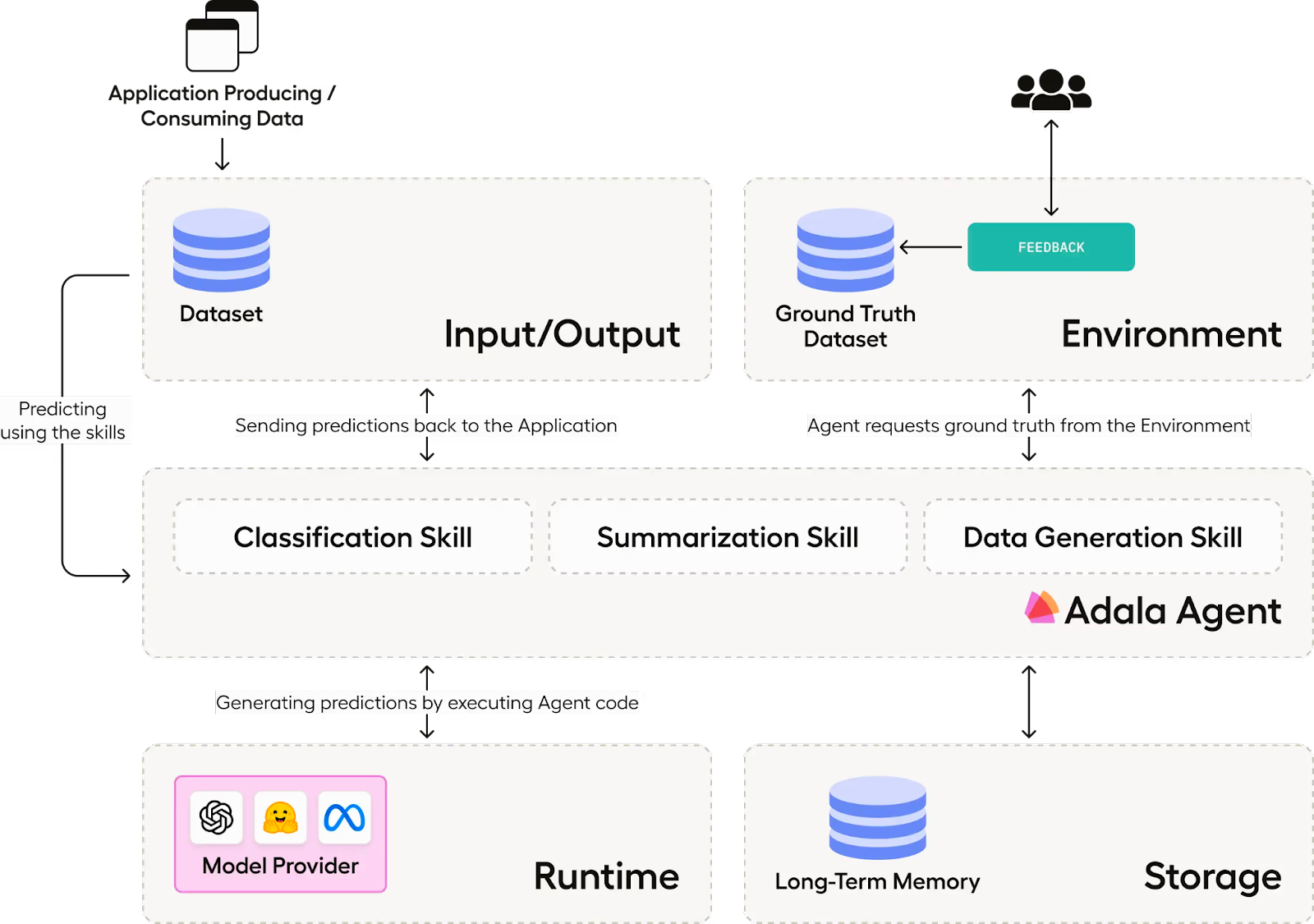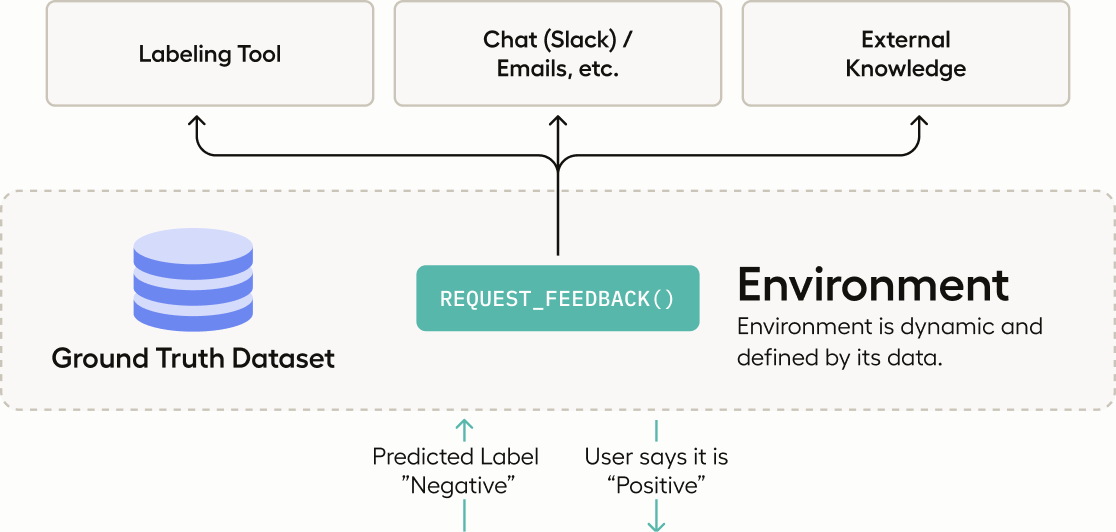📝 Guest Post: Adala – The First Open Source Data-Labeling Agent*
Was this email forwarded to you? Sign up here In this guest post, Jimmy Whitaker, Data Scientist in Residence at Human Signal, introduces Adala, an Autonomous Data Labeling Agent framework that harmonizes AI's computational power with human judgment. It challenges conventional AI paradigms with dynamic agents that not only learn and adapt but also heavily rely on human-labeled data as a foundational bedrock. While the technology is still in its nascent stages, it aims to redefine data processing, model training, and the development of AI applications. It’s open-source and you can contribute to it! Generative AI, exemplified by Large Language Models (LLMs) like ChatGPT, has moved beyond being a mere tool of natural-language chat to become an active collaborator in our day-to-day work. The concept of building agents with LLMs as their core runtime, or compute primitive, has emerged as a groundbreaking approach. These LLM-powered agents are not limited to generating well-articulated content but can be framed as potent general problem solvers. Yet, one might assume that with such progress, the need for traditional tasks like data labeling would diminish, with agents and other generative AI techniques picking up that burden. However, these systems still need to deliver correct and consistent results. Consequently, LLM-based systems still need to be guided by human insight, especially when it comes to domain-specific, or more complex or nuanced tasks, to ensure the quality, reliability and robustness of AI models. Enter Adala, a new Autonomous Data Labeling Agent framework. While it embodies the forefront of AI-driven data processing, Adala acknowledges and emphasizes the irreplaceable role of human-labeled data. It's not about replacing the human touch but harmonizing it with AI capabilities. While the technology behind the open source Adala framework is still early, we’re excited for you to explore the project, provide feedback, and contribute back. We believe Adala has the potential to reshape the landscape of data processing, model training, fine-tuning, and building AI applications. To help understand why, let’s dive into the architecture and how you would use Adala to continuously train and fine-tune AI models. Adala - A Data Labeling Agent FrameworkAt the heart of Adala lies a philosophy that challenges traditional AI paradigms. Unlike systems bound by static algorithms and predefined rules, Adala's agents are dynamic entities designed to learn, adapt, and evolve. This evolution is not random but is guided by experiences, data, and, most importantly, human feedback.
Agents are profoundly influenced by the context set for them. Typically, this context takes the shape of the prompts and skills provided to them. In the case of Adala, this context is primarily provided by a ground truth dataset. Such datasets, which can be created using platforms like Label Studio, serve as a foundational bedrock, guiding the agent's initial understanding and subsequent learning trajectories. As the environment evolves, perhaps by incorporating new ground truth data, agents further refine their skills, ensuring they remain relevant and accurate. Let’s look at an example. For a simple classification problem, we may create an agent with a “classification skill” to perform subjectivity detection. Initially, this skill may look as simple as defining instructions to retrieve labels from an LLM.
This skill may be sufficient for simple tasks, but it will likely miss the nuance in more complex examples. At this point, we could manually incorporate techniques like Chain of thought or ReAct. But a better way is to ground the skill with a ground truth dataset. During this process, the agent uses an evaluation stage to compute metrics for the ground truth data and automatically incorporates nuanced examples into the skill as a form of few-shot learning to improve the agent’s classification predictions. We can see an improved skill prompt learned from our ground truth data below.
The key here is that we leverage human input to direct the agent’s learning process and constrain the agent’s direction. The agent's learning process is controlled and refined by incorporating human feedback. Human annotators can further enhance the data curated by the agent, focusing on predictions that demand greater discernment and feeding this refined data back into the agent's learning cycle. The Building Blocks of Adala: Flexibility and Extensibility at its CoreThe strength of Adala lies in its modular architecture. Whether you’re looking to process data, generate synthetic data, or curate multimodal datasets, Adala provides the tools and framework to make it happen. At the core of Adala are three fundamental components: the environment, the agent, and the runtime. The Environment: Defined by DataThe environment in Adala is akin to the real-world context in which the agent operates. It supplies the essential data and sets the boundaries for the agent's operations. Crucially, this is the realm where human feedback is integrated, ensuring the agent operates with a clear and relevant context. The Agent: The Heart of AdalaThe agent is where the magic happens. It processes data, learns from it, and refines its actions based on environmental interactions. A standout feature of Adala's agents is their capability to craft custom skills. For instance, a classification skill can assess a dataset, scrutinize ground truth data, and enhance its performance based on human feedback. The versatility of these skills means they can be expanded to handle complex tasks, from intricate data curation to integrating student-teacher architectures or even tools tailored for computer vision. Additionally, agents can be equipped with a memory component, enabling them to tackle more advanced tasks. The Runtime: Powering Adala's OperationsThe runtime, or the LLM where the code executes, is the engine that drives Adala. It's the platform where the agent's skills come to life, ensuring Adala's seamless and efficient operation. Today, Adala supports OpenAI, but we are actively working to support more runtimes and are also seeking contributions to expand the library of available runtimes. The runtimes are designed for adaptability, allowing for integrating new tools, plugins, and features. Fundamentally, Adala's runtime is crafted to effortlessly incorporate into existing workflows, ensuring a smooth fit within data processing pipelines. Adala - Pioneering the Future of Human-AI CollaborationThe quest for efficiency and quality often comes with a hefty price tag. Traditional data processing methods, while effective, can be resource-intensive and costly. Adala’s vision is compelling: a future where AI doesn't replace humans but collaborates with them. A future where the computational prowess of AI agents and the nuanced understanding of humans come together in perfect harmony, ensuring outputs that are efficient, cost-effective, and of the highest quality. The journey for Adala is just beginning. The potential of this technology is yet to be fully realized, and we can all contribute to shaping what’s possible. Explore Adala, and join us virtually on Nov 7th for a live demo and overview of Adala’s agent-based approach to data labeling. *This post was written by Jimmy Whitaker, Data Scientist in Residence at Human Signal. We thank HumanSignal for their insights and ongoing support of TheSequence.You’re on the free list for TheSequence Scope and TheSequence Chat. For the full experience, become a paying subscriber to TheSequence Edge. Trusted by thousands of subscribers from the leading AI labs and universities. |
Older messages
Generative AI is the New Wall Street Earnings Kingmaker, and Microsoft is the New Earnings King
Sunday, October 29, 2023
Sundays, The Sequence Scope brings a summary of the most important research papers, technology releases and VC funding deals in the artificial intelligence space.
📝 Guest Post: The Coming Wave of Specialized AI*
Friday, October 27, 2023
In this blogpost, Piero Molino, author of Ludwig.ai, CSO & Co-Founder at Predibase, will make the case for why smaller, faster, fine-tuned LLMs are poised to take over large, general AI models.
Edge 338: Inside WebAgent: Google DeepMind's Instruction-Tuned LLM that can Complete Tasks on Websites
Thursday, October 26, 2023
The model combines language understanding and web navigation.
Edge 337: Understanding QLoRA
Tuesday, October 24, 2023
How a simple and effective optimization on LoRA resulted in an incredibly efficient fine-tuning method.
📝 Guest Post: LLMs & humans: The perfect duo for data labeling
Monday, October 23, 2023
How to build a pipeline to achieve superhuman quality
You Might Also Like
Import AI 399: 1,000 samples to make a reasoning model; DeepSeek proliferation; Apple's self-driving car simulator
Friday, February 14, 2025
What came before the golem? ͏ ͏ ͏ ͏ ͏ ͏ ͏ ͏ ͏ ͏ ͏ ͏ ͏ ͏ ͏ ͏ ͏ ͏ ͏ ͏ ͏ ͏ ͏ ͏ ͏ ͏ ͏ ͏ ͏ ͏ ͏ ͏ ͏ ͏ ͏ ͏ ͏ ͏ ͏ ͏ ͏ ͏ ͏ ͏ ͏ ͏ ͏ ͏ ͏ ͏ ͏ ͏ ͏ ͏ ͏ ͏ ͏ ͏ ͏ ͏ ͏ ͏ ͏ ͏ ͏ ͏ ͏ ͏ ͏ ͏ ͏ ͏ ͏ ͏ ͏ ͏ ͏ ͏ ͏ ͏ ͏ ͏ ͏ ͏ ͏ ͏ ͏
Defining Your Paranoia Level: Navigating Change Without the Overkill
Friday, February 14, 2025
We've all been there: trying to learn something new, only to find our old habits holding us back. We discussed today how our gut feelings about solving problems can sometimes be our own worst enemy
5 ways AI can help with taxes 🪄
Friday, February 14, 2025
Remotely control an iPhone; 💸 50+ early Presidents' Day deals -- ZDNET ZDNET Tech Today - US February 10, 2025 5 ways AI can help you with your taxes (and what not to use it for) 5 ways AI can help
Recurring Automations + Secret Updates
Friday, February 14, 2025
Smarter automations, better templates, and hidden updates to explore 👀 ͏ ͏ ͏ ͏ ͏ ͏ ͏ ͏ ͏ ͏ ͏ ͏ ͏ ͏ ͏ ͏ ͏ ͏ ͏ ͏ ͏ ͏ ͏ ͏ ͏ ͏ ͏ ͏ ͏ ͏ ͏ ͏ ͏ ͏ ͏ ͏ ͏ ͏ ͏ ͏ ͏ ͏ ͏ ͏ ͏ ͏ ͏ ͏ ͏ ͏ ͏ ͏ ͏ ͏ ͏ ͏ ͏ ͏ ͏ ͏ ͏ ͏ ͏ ͏ ͏
The First Provable AI-Proof Game: Introducing Butterfly Wings 4
Friday, February 14, 2025
Top Tech Content sent at Noon! Boost Your Article on HackerNoon for $159.99! Read this email in your browser How are you, @newsletterest1? undefined The Market Today #01 Instagram (Meta) 714.52 -0.32%
GCP Newsletter #437
Friday, February 14, 2025
Welcome to issue #437 February 10th, 2025 News BigQuery Cloud Marketplace Official Blog Partners BigQuery datasets now available on Google Cloud Marketplace - Google Cloud Marketplace now offers
Charted | The 1%'s Share of U.S. Wealth Over Time (1989-2024) 💰
Friday, February 14, 2025
Discover how the share of US wealth held by the top 1% has evolved from 1989 to 2024 in this infographic. View Online | Subscribe | Download Our App Download our app to see thousands of new charts from
The Great Social Media Diaspora & Tapestry is here
Friday, February 14, 2025
Apple introduces new app called 'Apple Invites', The Iconfactory launches Tapestry, beyond the traditional portfolio, and more in this week's issue of Creativerly. Creativerly The Great
Daily Coding Problem: Problem #1689 [Medium]
Friday, February 14, 2025
Daily Coding Problem Good morning! Here's your coding interview problem for today. This problem was asked by Google. Given a linked list, sort it in O(n log n) time and constant space. For example,
📧 Stop Conflating CQRS and MediatR
Friday, February 14, 2025
Stop Conflating CQRS and MediatR Read on: my website / Read time: 4 minutes The .NET Weekly is brought to you by: Step right up to the Generative AI Use Cases Repository! See how MongoDB powers your





